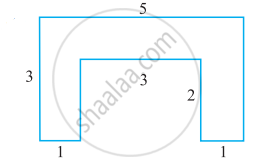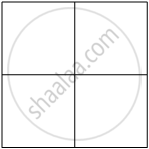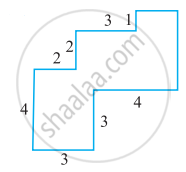Advertisements
Advertisements
प्रश्न
By splitting the following figure into rectangles, find their areas (The measures are given in centimetres).

उत्तर

Area of brown region = 3 × 1
= 3 cm2
Area of orange region = 3 × 1
= 3 cm2
Area of grey region = 3 × 1
= 3 cm2
Total area = 3 + 3 + 3
= 9 cm2
∴ The total area is 9 cm2.
APPEARS IN
संबंधित प्रश्न
If the side of a square is tripled, how many times the perimeter of the first square will that of the new square be?
As shown in the figure, four napkins, all of the same size, were made from a square piece of cloth of length 1 m. What length of lace will be required to trim all four sides of all the napkins?

The area of a rectangular piece of cardboard is 36 sq cm and its length is 9 cm. What is the width of the cardboard?
The side of a square is 6 cm. The length of a rectangle is 10 cm and its breadth is 4 cm. Find the perimeter and area of both the square and rectangle
Anmol has a chart paper of measure 90 cm × 40 cm, whereas Abhishek has one which measures 50 cm × 70 cm. Which will cover more area on the table and by how much?
Divide the park shown in the figure of question 40 into two rectangles. Find the total area of this park. If one packet of fertilizer is used for 300 sq m, how many packets of fertilizer are required for the whole park?
The length and breadth of a rectangle are as given below:
9m and 6m
What is the cost of tiling a rectangular plot of land 500 m long and 200 m wide at the rate of ₹ 8 per hundred sq m.?
By splitting the following figure into rectangles, find their areas (The measures are given in centimetres).

The perimeter of a rectangle is 40 m. Its length is four metres less than five times its breadth. Find the area of the rectangle.
